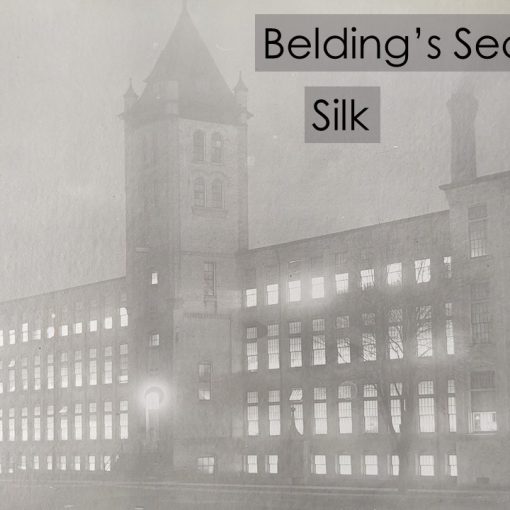Heading into a small boutique in the basement of the Traverse City State Asylum, I introduced myself to a shopkeeper, “Hi! I’m Martha, a travel blog writer. What stories can you share about this hospital?”
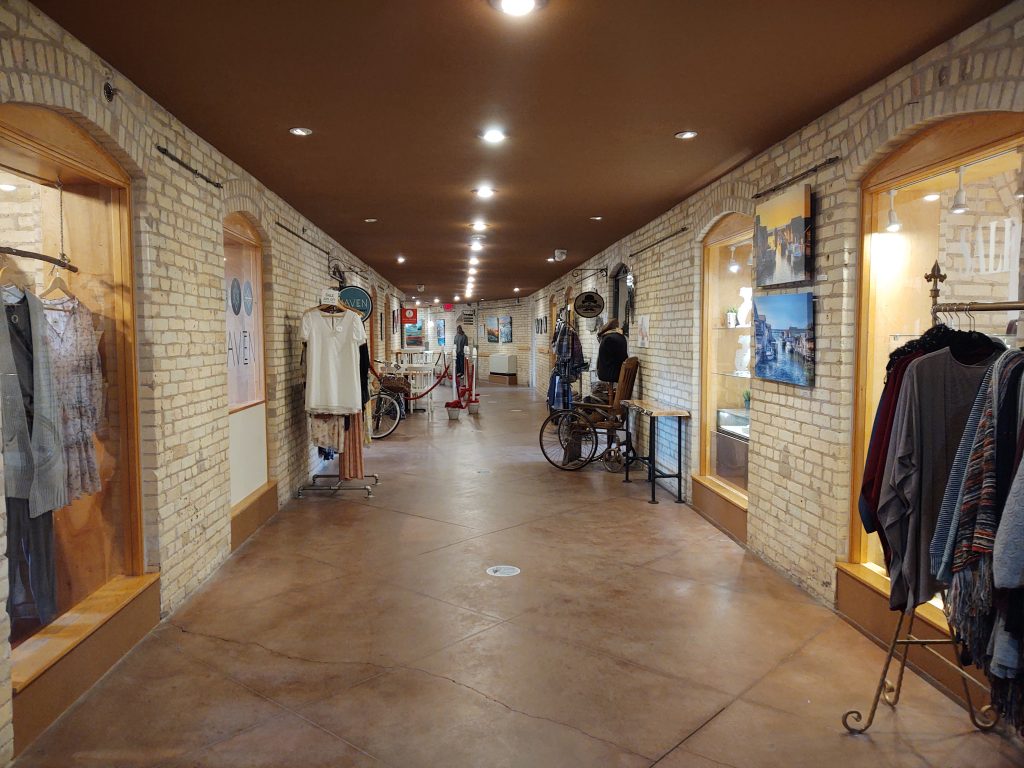
A white puff-ball dog entered the shop and crossed to the counter with determination. The shopkeeper dispensed a treat calling the puppy by it’s name, “Hello, Angel.” Turning back to me she gestured at a display table, “‘Beauty is Therapy’ is a great book covering practically the whole history of the State Hospital.” A large husky strode toward the counter for a delicacy. “Scout, how are you today?” She turned her attention to the sturdy dog whose wagging created a breeze.
The basement of Building 50 now houses boutiques and cafes. The floors above are filled with residents who live in renovated condos. It seemed each person owns a dog who merrily trots to the counter for a treat from the kind lady as part of the daily routine. I purchased the book, realizing the store manager was too busy with her furry friends to chat. As I was merging into the hallway to browse other venders a tan lab strutted by me with a gleam in his eye.
Glancing at the back of the book “Beauty is Therapy” I noticed that this father and son’s life story would fill so many curiosities about the Traverse City State Hospital. They had both been employed as gardeners over the span of 66 years.
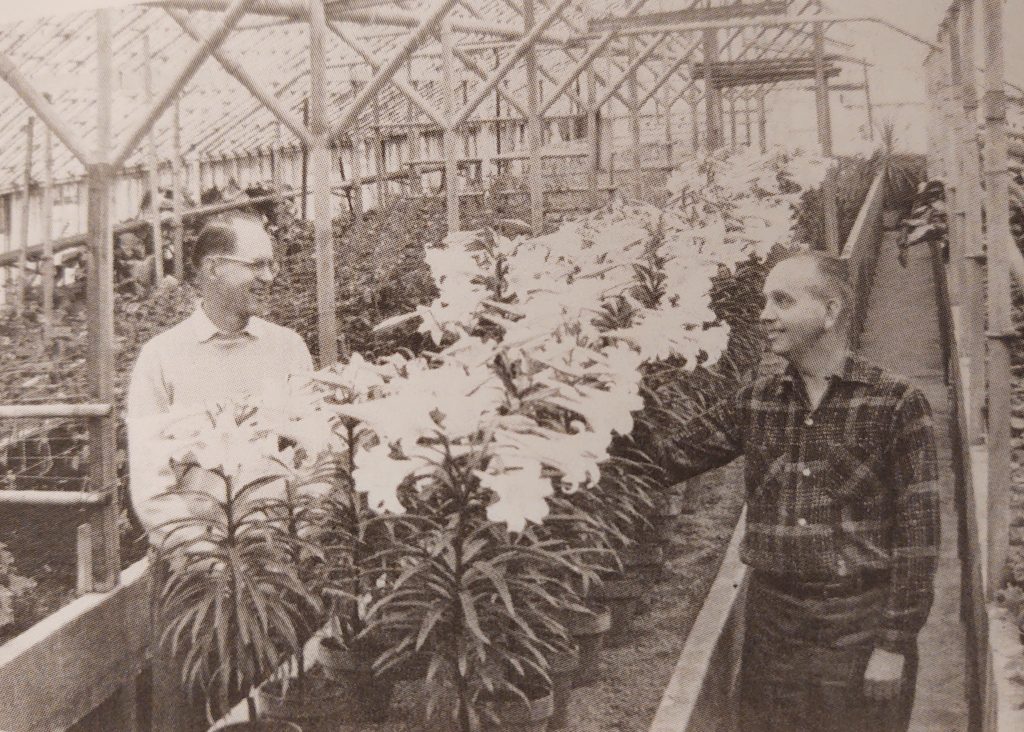
Photo Credit: Kristen M. Haines, “Beauty is Therapy”
It was 1922 and nine year old Earle Steele moved from Grand Rapids, Michigan to Traverse City where his father, Edgar H. Steele, had been hired as the florist and gardener for the Traverse City State Hospital. Earle and his mother arrived at 11:00 pm by train on the wintery March night. His father met the two at the station with the only local taxi, a 1921 Model T. The driver steered the wooden spoked tires using great force and trudged through the rutted, snow covered street to the hospital. Power steering hadn’t been developed yet.
Their cottage home on the hospital grounds had been built in 1890 and renovated in 1922 with new heating, electrical and some interior updates at well. Electrical cords dropped from the ceiling. The cooking stove was gas powered but could also burn wood. They had a gas powered clothes washer placed in the only bathroom in their home.
That first morning Earle was suddenly awakened by the piercing screech of the power plant whistle. It sounded daily at 7:00 am, 11:30 am and 5:00 pm. On Mondays it would sound with short blasts to signify a fire drill. The Traverse City State Hospital was the first of the three state hospitals to have electricity provided by it’s own power house. There had been four electricians on staff when Earle was young. Later ten employees were in charge of the electrical department.
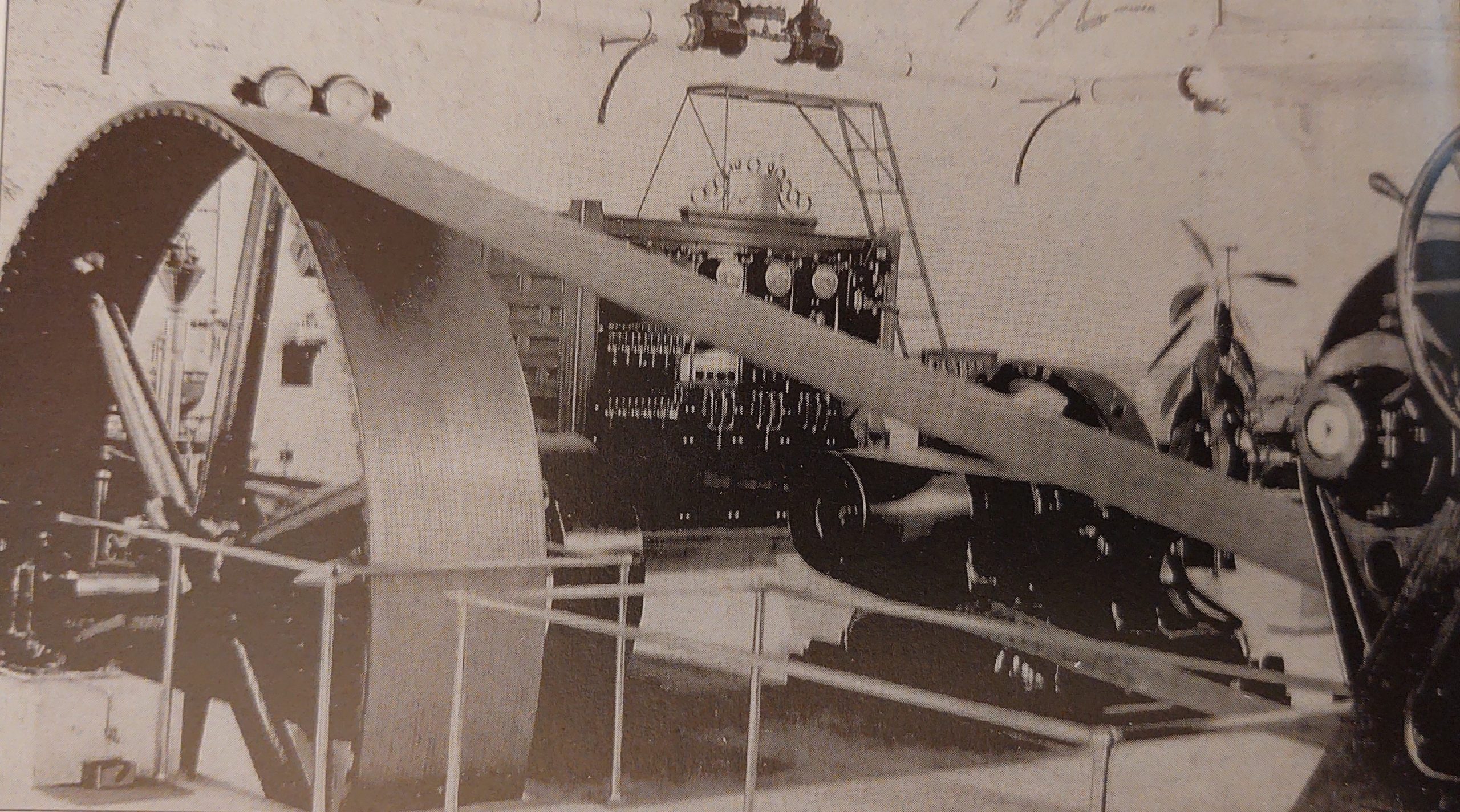
Photo Credit: Traverse City State Hospital
The power plant would burn sixty-five tons of coal a day during the winter. The hospital had a standard delivery throughout the year so it would have supplies for the coldest season. The coal would arrive by boat, years later by train. Earle was impressed with the supply obtained in the summer. The coal would be stacked three stories high.
The Steele family was the first on the property to have a car. Their cottage had an attached garage, but it was the size of a shed. So, a new garage was built by some inmates. Mostly, people used horse and buggy or sleighs to move about the area in the 1920’s and 30’s.
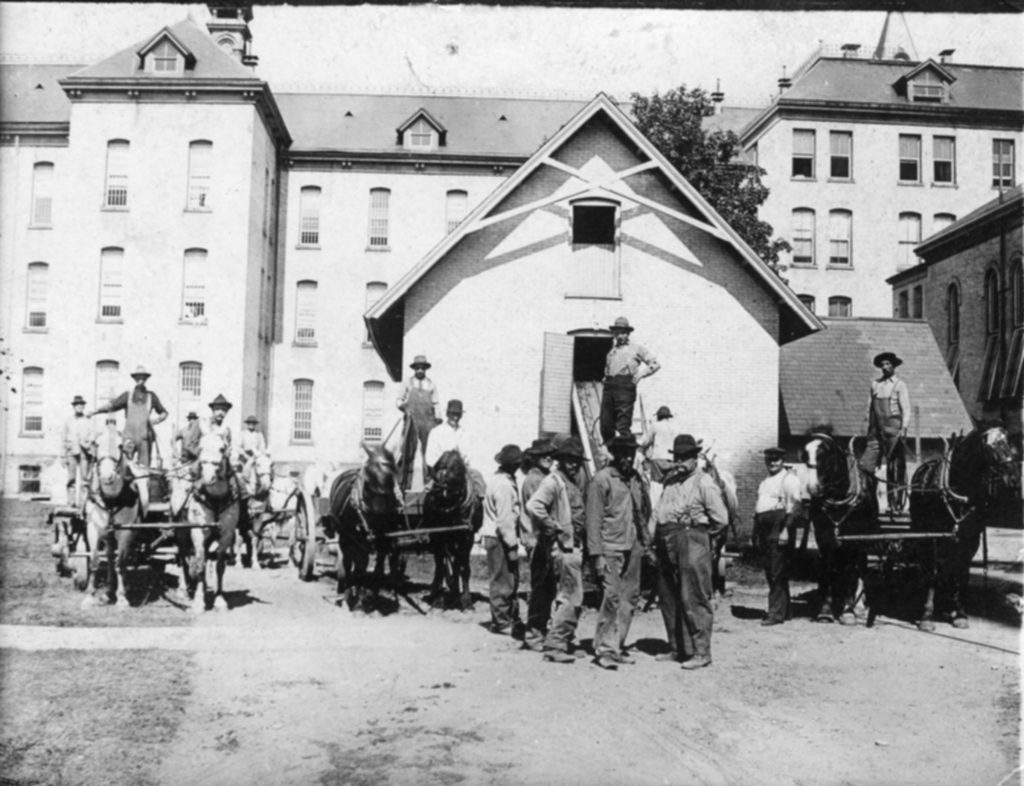
“The Cookie Wagon” would deliver meat, milk and baked goods about the campus until 1938. Earle had been delighted when the driver invited him to ride along. On these routes to the four kitchens he witnessed a “the friendliness that existed between employees, regardless of department, and patients.”
After the last delivery, the team of horses took a ‘full tilt’ gallop to their barn. The empty milk cans jostled from side to side. The lively pair passed Earle’s home with no chance of stopping to drop him off. They cantered until they reached their stalls one half mile away. Earle said he didn’t mind the walk back to his home.
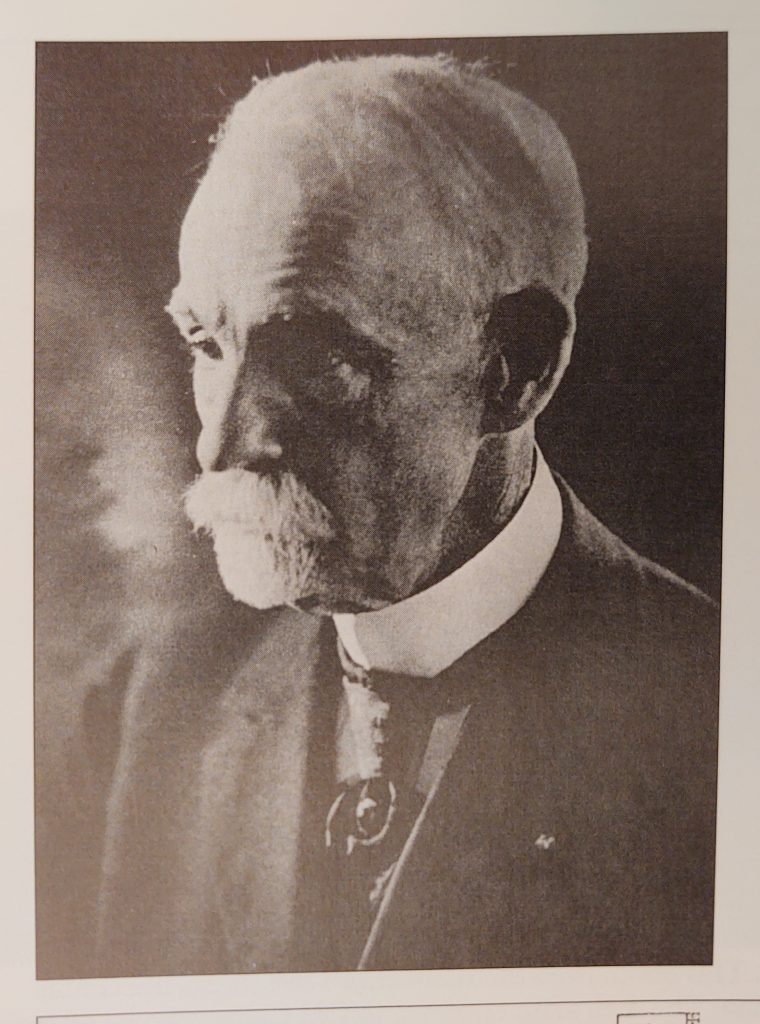
Photo Credit: Traverse City State Hospital
Dr. James Munson, the superintendent, had donated his team of horses to the hospital for deliveries and farm work. Earle found Dr. Munson to be “a very gracious and gentle person.” “I was always made to feel welcome.”
Dr. Munson’s son joined the army during WWI. Sadly, during training his son died of the flu pandemic in 1917. “Even during the busiest times, when he was checking ward areas, Dr. Munson would stop and visit.” Earle reminisced.
Dr. Munson’s belief was that work was therapeutic. It provided patients with a purpose and helped to keep the hospital running smoothly with laundry, farming and grounds care. The patients were never paid for their labor which became an issue with labor unions. After a few decades these work programs were disbanded.
Patients had free reign around the hospital campus. Many would be seen working on the grounds. Earle recalled groups of male patients using “coal scoops” to shovel snow on the walkways. Earle recalled that the doors to their home were always left unlocked.
“Beauty is Therapy” was another premise of Dr. Munson’s treatment. The grounds were stunning and still are today. There are many hiking trails and an amazing variety of trees, thanks to Dr. Munson. He would return from trips with a selection of young trees. Edgar, Earle’s father, would plant these on the property.
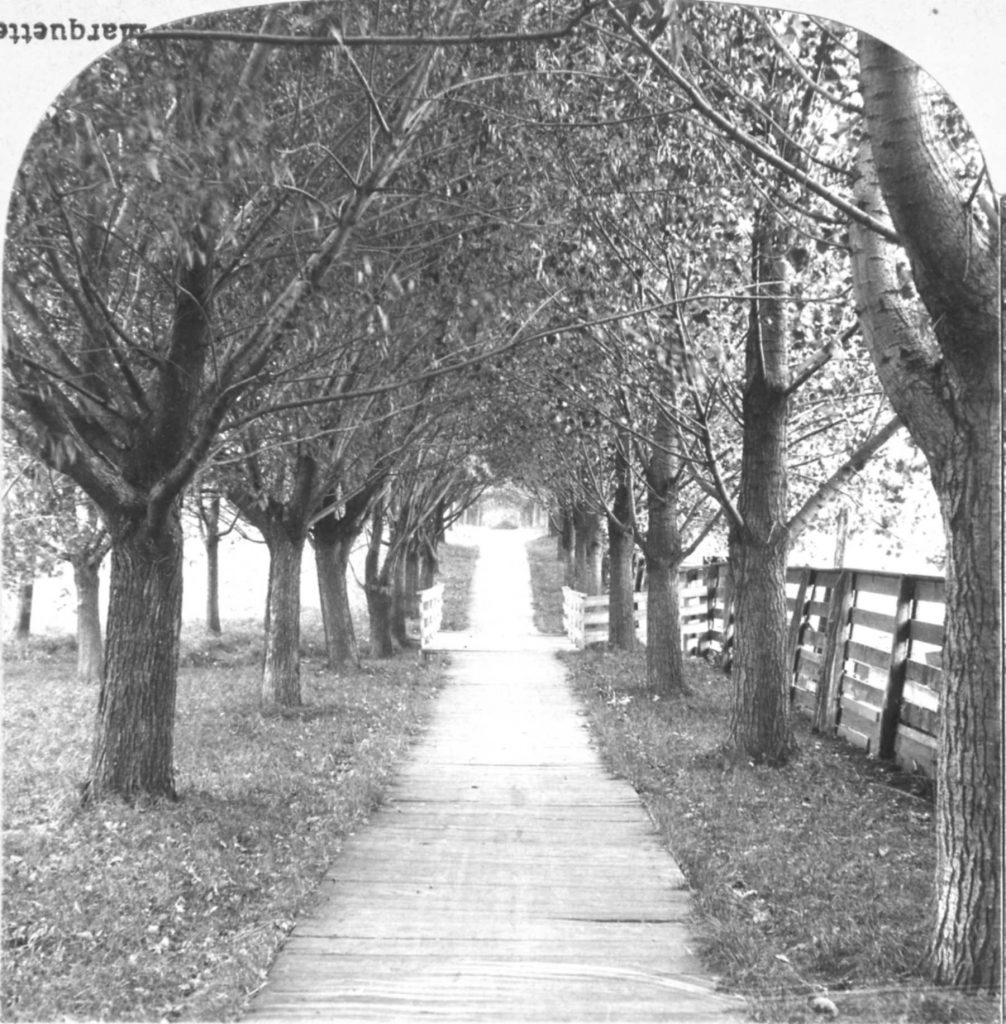
Photo Credit: Traverse City Historical Society
Dr. Munson’s collection of trees grew into an arboretum. (Years later in the 1960’s Dr. Duane Sommerness, the superintendent at the time, had metal name tags put on all the trees. School groups would take field trips to the campus.)
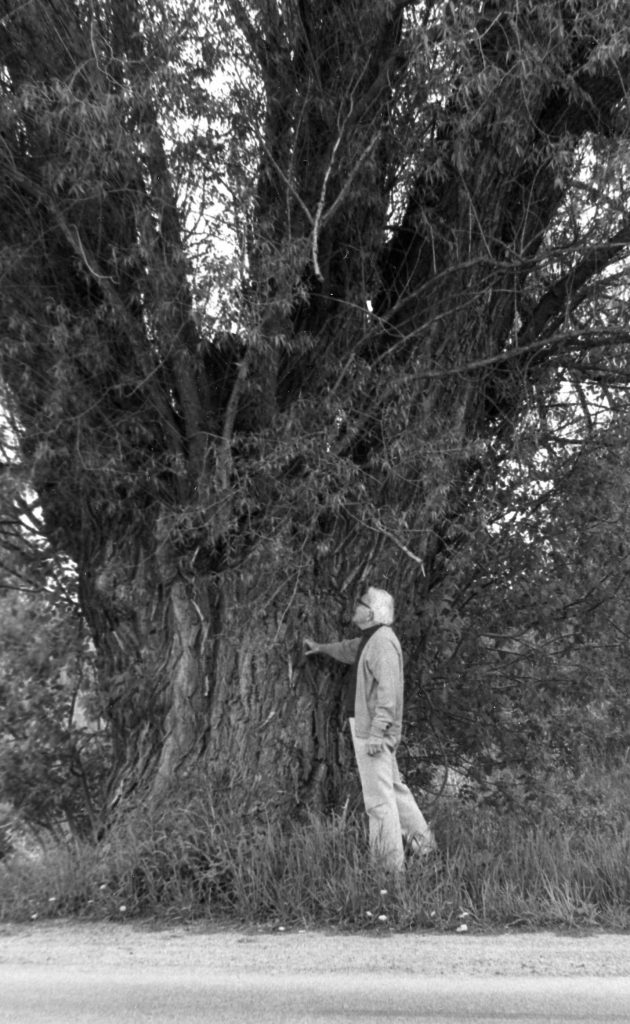
Photo Credit: Traverse City Historical Society
Earle said, “My father did an immense amount of planting in this area during his years of employment. ”
In April Earle was signed up for fourth grade after starting in fourth grade in Ann Arbor the past fall, but after a week he was returned to the third grade at Union Street School, where St. Francis church is now. He took it in stride. In 1933 Earle graduated.
Being the only child living on the hospital grounds entertainment included reading and listening to the radio in the 1920’s and 30’s. There was a library on the hospital grounds as well as the one on Sixth Street. Once a month his father would take the family to the Dreamland movie theater on Front Street. Tickets cost twenty-five cents for an adult and ten cents for a child. Westerns were his father’s favorite type of movie.
In the summer the family of three would get ice cream cones at Wahl’s and then watch the train “the resort special on its way south from Petosky.” Feeling the thunder of it and seeing the billowing clouds of steam rolling over the locomotive and Pullman coach cars was a treat. This train was carrying vacationers between Petosky and Chicago.
Large passenger ships would dock in Traverse City three times each week during the 1920’s and 30’s. They would be in port for only two hours on their way from Mackinac Island to Chicago. It was exciting to watch the supplies being loaded.
At 13 years old Earle became mysteriously ill. The doctor did exploratory surgery to find a “villainous” appendix which was removed. Due to the difficult surgery, Earle was confined to bed for four months. Dr. Munson requested that an elderly patient, who maintained the hospital library, deliver a book or two to Earle each week. Well, this gentleman delivered “twenty to thirty books at a time.”
As he grew up one of Earle’s favorite pastimes was to visit his father in the greenhouses. In the wintery months it was “especially nice to be surrounded by greenery. “
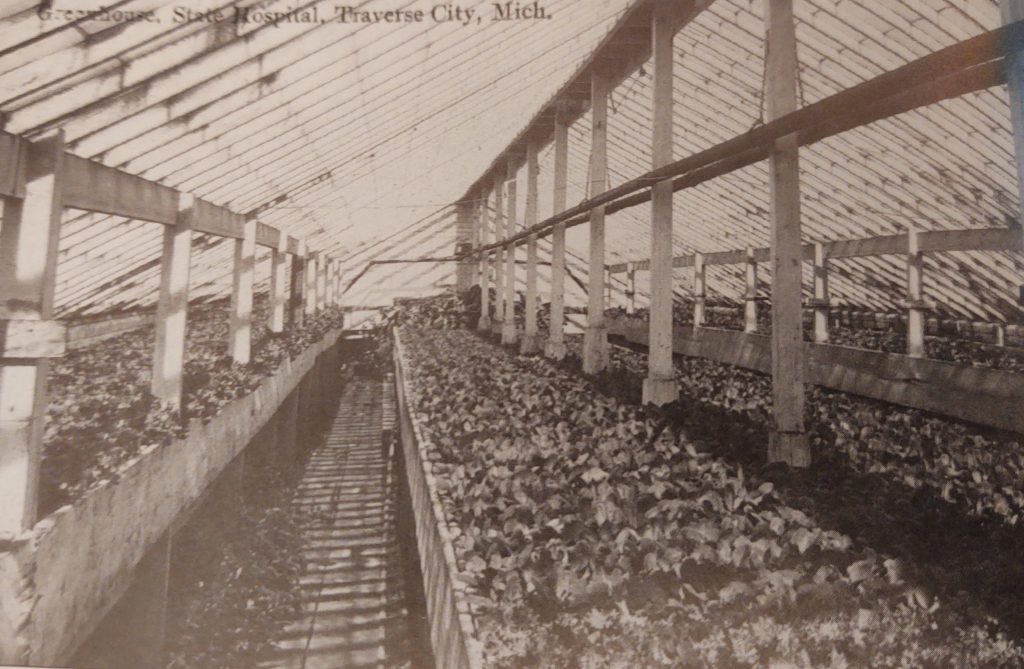
Photo Credit: Traverse City State Hospital
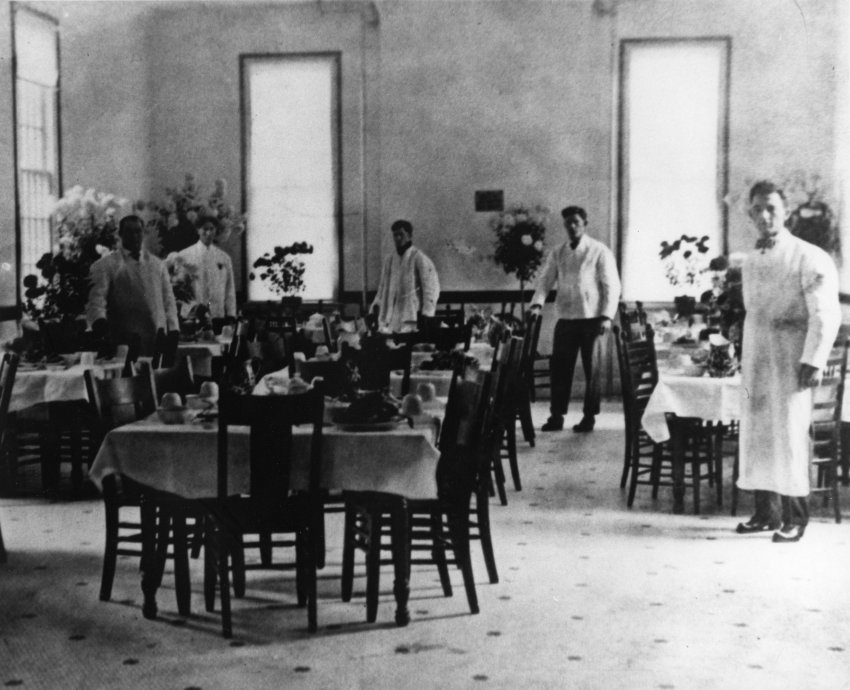
Notice the fresh flowers provided by Edgar Steele and his team.
Photo Credit: The Traverse City Historical Society
There were five patients who worked in the greenhouses with his father year round. There were many nationalities represented: Norwegian, Hungarian, Austrian, Polish and German. Many foreign born patients had arrived in the U. S. with big dreams and suffered nervous breakdowns causing institutionalization. Many people feel fearful when confronted with mentally ill individuals, however Earle wrote, “The patients treated me very well.”
A civil engineer had developed manic depression. This man constructed a pair of skis for Earle. He also made a toboggan which Earle used for years. In the summer this gentleman would design many different types of kites.
A banking executive who “fell on hard times” taught Earle about trout fishing in the stream that ran across the property. He also instructed Earle about which wilderness fruits that were safe to eat.
Another resident had been fishing, too, and asked Earle to join him. Earle’s father shared a serious tone about this patient. “I don’t want you to go with him.” Later, Earle learned that this man had been a farmer in Mount Pleasant. He and his son had been riding in a fully loaded hay wagon when his son threw his apple core at the horse. The animal got spooked and the cart overturned. This man became so angry with his son that he stabbed his son to death with a splintered piece of wood.
In 1934 Earle’s father, Edgar, became ill and was diagnosed with terminal cancer. Dr. Sheets, the superintendent, made an agreement that Earle would work as an assistant in the greenhouse. This would allow his father’s paychecks and their housing to continue while Edgar received medical care. While his parents were in Ann Arbor seeking treatment, Earle lived in the cottage alone and took his meals in the dining area with residents and employees. Earle stated he was not a “model employee.” At nineteen years old he “festered a rebellious attitude.”
Earle’s father, Edgar Steele, passed away on December 2, 1934. His funeral was held in Grand Rapids. Earle vividly recalled his train trip returning to the hospital and how much it had mirrored his original relocation to Traverse City when he had been nine years old.
Their arrival on that brisk, late wintery night was met by friends who graciously allowed Earle and his mother to reside in their home until the pair could establish their own housing. The cottage where they had been living on the hospital grounds was reserved for the head florist and that position was being taken over by the previous assistant gardener along with a wage of $100.00 a month.
On December 12, 1934 Earle was offered the assistant gardener position with a wage of $85.00 a month and no housing allowance. He was provided with meals during his work hours. Earle and his mother found a room to rent on 11th Street, a half hour walk to and from the hospital.
Earle continued in his father’s footsteps, wishing he had paid better attention during his childhood visits to the greenhouse. Earle had a lot to learn and was determined to do so. He cared for the variety of trees in the arboretum area as well as the grounds. He tended to the crops and flowers in the greenhouses. He maintained many relationships with co-workers and patients alike.
His mother’s friends urged her to move back to Ann Arbor. She found a housekeeper position for a newly widowed man with two small children. She never returned to Traverse City.
Earle planned to marry a local woman named Marion and started pursuing a change in employment by interviewing at the Connors Creek Plant in Detroit. This would bring him closer to his mother, too. However, before he was able to meet with the superintendent of the hospital to share his plans, Mr. Leland, the head of the greenhouse, suffered a severe heart attack. Mr. Leland would be unable to work for three months or more.
With The Great Depression barely behind them and a war going on in Europe, Earle and Marion decided to stay in Traverse City where Earle had secure employment. They were married in June of 1940. Marion took a job at her family’s drug store. They made their home in the upstairs of 640 State Street. Earle received a raise and was now earning $110.00 monthly plus he had meal tickets for eating at the hospital during his working hours.
In 1941 he and his wife welcomed their baby, Ron. Building a family during wartime was precious and created a sense of positive purpose. Earle earned a promotion and was now earning $125.00 monthly. Earle and his wife Marion purchased their first car from her parents. Travel was minimal due to restrictions on gas, however they had plenty of entertainment watching Ron. In 1946 Marilyn was born. They sold their car. The maintenance costs were increasing while they had another little one in their family. Earle took a taxi or walked to and from work.
Earle continued ha variety of relationships with patients and staff members. One was an 80 year old, recently widowed resident, who started to diminish in his reality, could easily recall stories from working in Chicago. Earle loved hearing tales of the big city. He asked Earle to bring the Chicago Tribune for him to read.
In 1942 this man asked if Earle could take pictures of the grounds so he could send them to his daughter. Earle obliged and photographed “Pikes Peak,” the highest location overlooking Traverse Bay. Soon an FBI agent was calling with questions. The FBI had notified all film developers to watch for suspicious views of local areas. During this wartime, the FBI was keeping a look out for any potential threats.
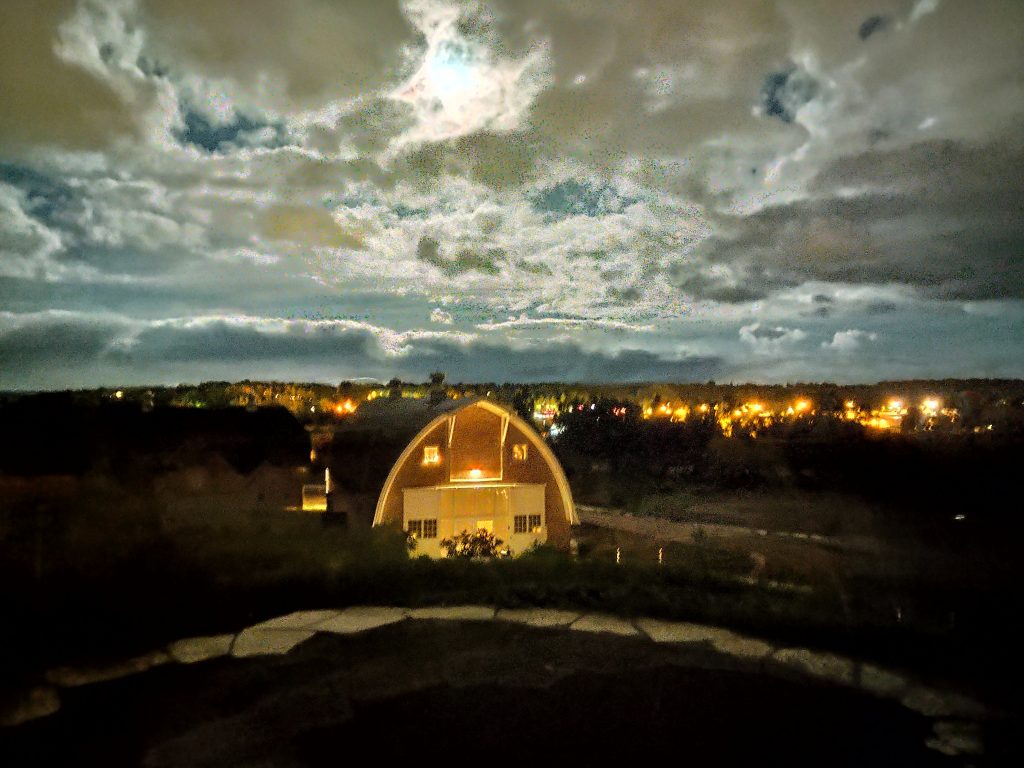
Earle recalled one resourceful young male resident who built a wheeled cart. He must have had a supplier from a grocery store because his cart was filled with candy bars, cigarettes and other trinkets. On Sundays and holidays he’d push his canvas covered cart and sell these items. He wasn’t permitted to enter the building so residents devised small bags on long strings to conduct business from their elevated housing. Lowering their sack with coins to the salesman/patient. He would place their treats inside these bags which were hauled up quickly. Shortly after the invention of the cart, the Canteen Snack Shop was opened and put him out of business.
Tobacco was a popular commodity. It would arrive from the State Department warehouses in huge sheets of 30 by 40 inches. These would be cut into one by two inch rectangles and distributed twice weekly per patients’ requests. Rolling your own cigarettes was tedious and discouraged some residents from taking up the habit.
Patients were allowed to carry matches. Curiously only one fire was intentionally set during Earle’s time at the hospital. A young woman had been denied permission to smoke in the common room. She was caught by another resident trying to start a fire in her closet. The young woman’s ‘ground parole’ was revoked for several days. According to Earle this was fitting as ‘ground parole’ was a “cherished privilege.”
In the book, Earle explained that many who were hospitalized had “given into their imaginative states.” He reminisced about a few characters.
One male resident believed he was a billionaire and would own a cookie factory. The cookies would be frosted with gold dust and would be given away for free!
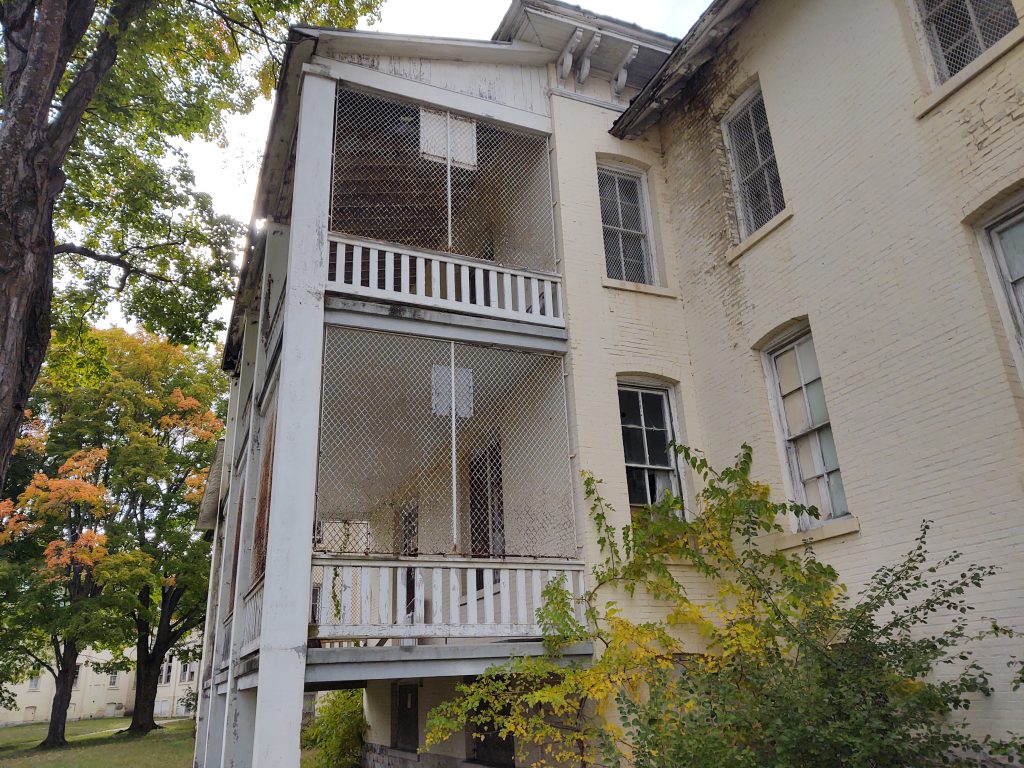
Another man on the screened porch of the TB cottage believed he was God. He would call out orders in a loud voice as his rocking chair squeaked.
Another patient would disrobe at the water reservoir every day with no concern for the weather. The water fell from an 18 foot spillway. Earle said that everyone could hear this man’s exclamations from a mile away as he stood under the cascade of cold water.
In the 1950’s the Hospital purchased property on Traverse West Bay for a picnic ground for the patients. A ‘changing house’ was constructed. Every department made contributions to improvements to the area. It was used by residents until the hospital closed in 1989.
Earle’s mother continued to work in housekeeping until 1953 when she fell ill. She had just passed her mandatory physical for her job at St. Joseph’s Mercy Hospital and two weeks later had a stroke. A week later she had a massive stroke and sadly passed away.
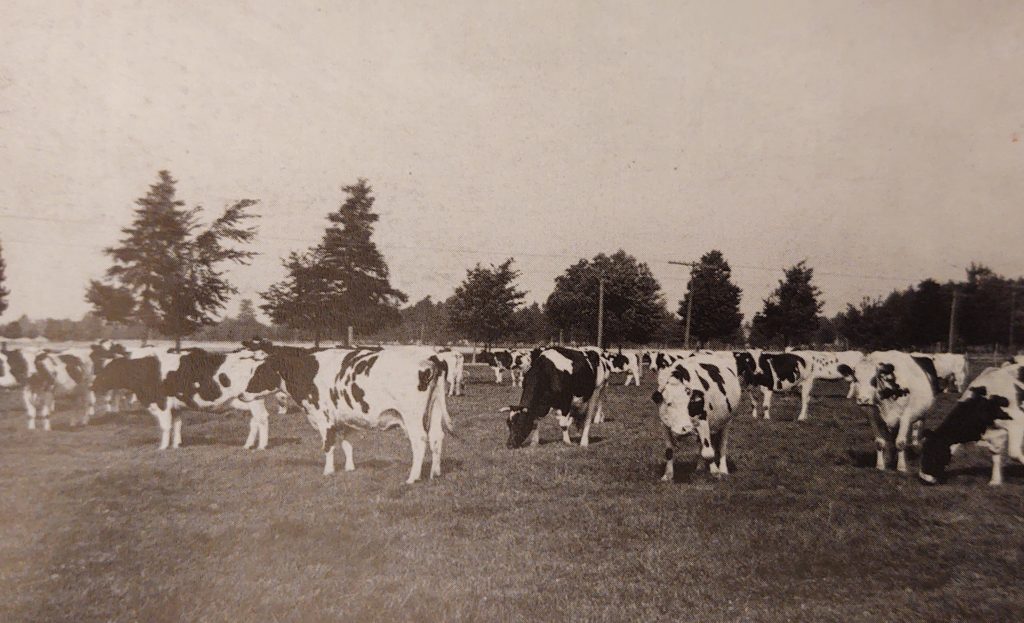
At this time the legislature in Lansing continued to pass directives to cease farming production activities at the Traverse City State Hospital. In 1956 the whole dairy department was slated to close. The dairy herd of 400 Holstein cattle was sold in 1957. Earle and his cohorts began to suspect that these were an early signs of an upcoming closure to the institution.
In the early 1960’s a staff gala was held. Three hundred employees were seated in the large auditorium where individuals were recognized for “service beyond the call of duty.” Earle humbly shared that he was called up to the stage three times. Earle’s life moto had been to be respectful of the residents, be sympathetic and understanding. This was evident and well recognized by everyone.
Holidays were difficult for the patients. Many residents were given permission to go home, but their families refused to let them join their gatherings. Many of these residents slid into a deep depression. The staff tried their best to accommodate the remaining ensemble with cards and small gifts. The individuals who were able to attend their family gatherings returned with heavy hearts. January was a dark time at the hospital.
In the 1960’s Ohmer Curtis, Community Relations Officer, reached out to the 39 county’s church groups and social clubs asking for donations to brighten the patients’ holidays. There was such an immense response that Earle had been brought over from the greenhouse to help sort and catalog the gifts so the donors could be thanked later. Nearby groups wrapped these items which were distributed to patients for the holidays. This became an annual tradition which Earle enjoyed being a volunteer even after his retirement until the hospital closed in 1989.
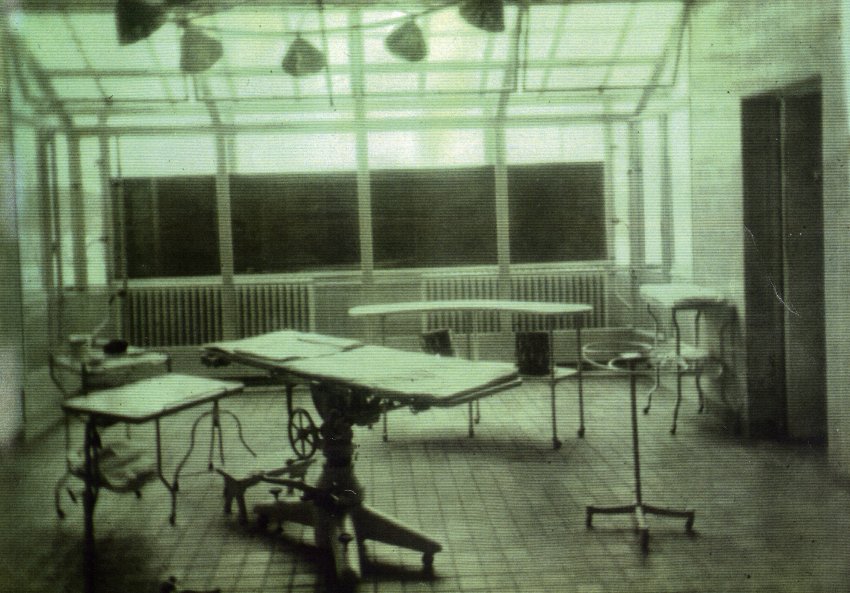
Photo Credit: Traverse City Historical Society
In 1978 Earle was given the task of finding storage for many artifacts which had been left in one of the closed buildings. He created a museum for these pieces of history. It was open daily for three years with nearly 8,000 people visiting. Even after Earle’s retirement in 1984, he maintained the museum voluntarily. Sadly, when the institution closed in 1989, the museum was forced to follow suit.
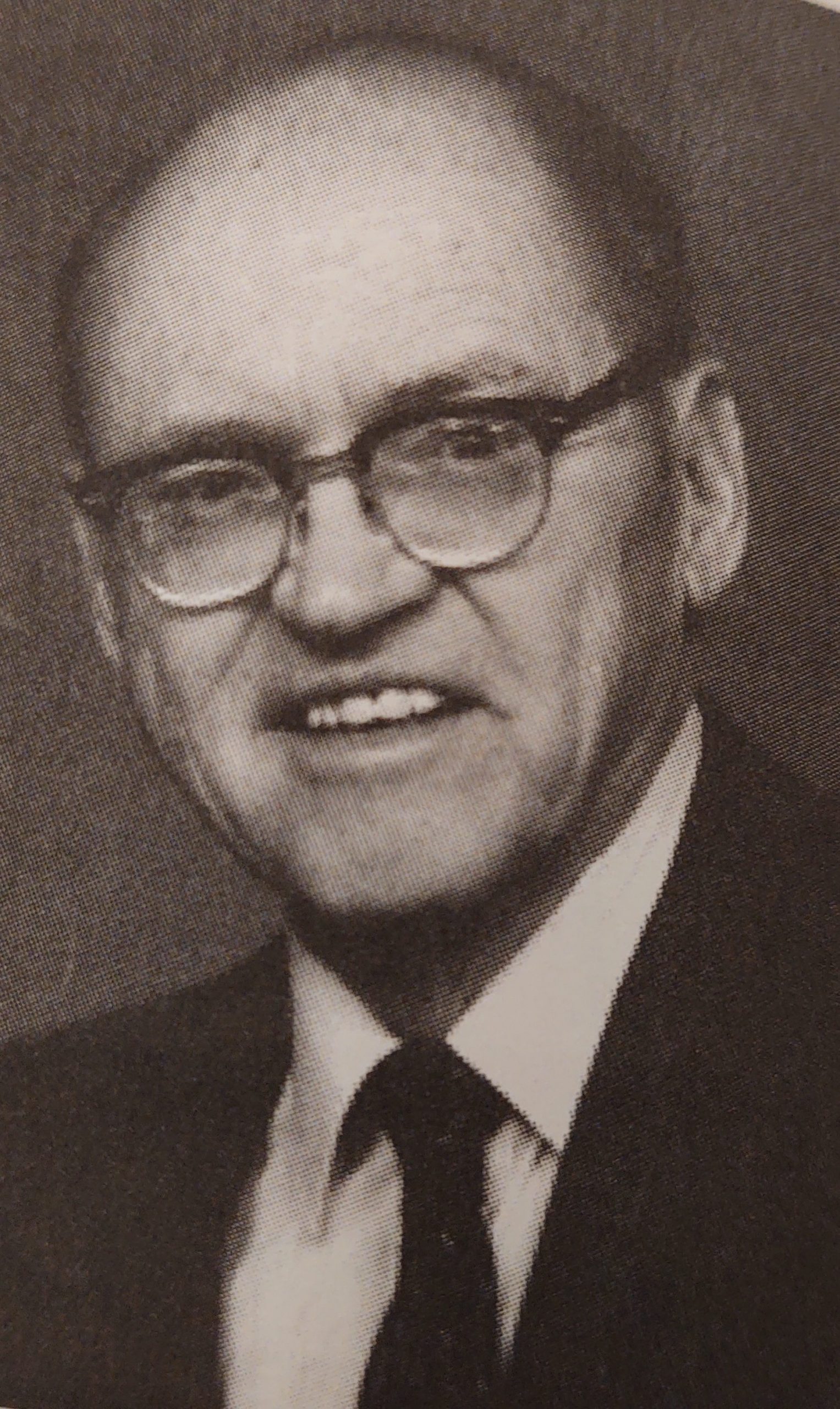
March 14, 1914 – August 15, 2003
He and his wife, Marion, had two children, nine grandchildren and fourteen great-grandchildren.
Photo Credit: Kristen M. Hains, “Beauty is Therapy”
Earle’s memories of his 66 year affiliation with the institution capture the entire history of the Traverse City State Hospital which spans through each of the superintendents. (1885-1989) Earle’s granddaughter, Kristen M. Hains, assembled the book through letters, “so history will not be forgotten.” “There are few trees on the hospital grounds that were not planted by my grandfather or my great grandfather.”
Resources:
“Beauty is Therapy” by Earle Steele and Kristin M. Hains 2001
“Traverse City State Hospital” by Chris Miller 2005
Traverse City Historical Society




